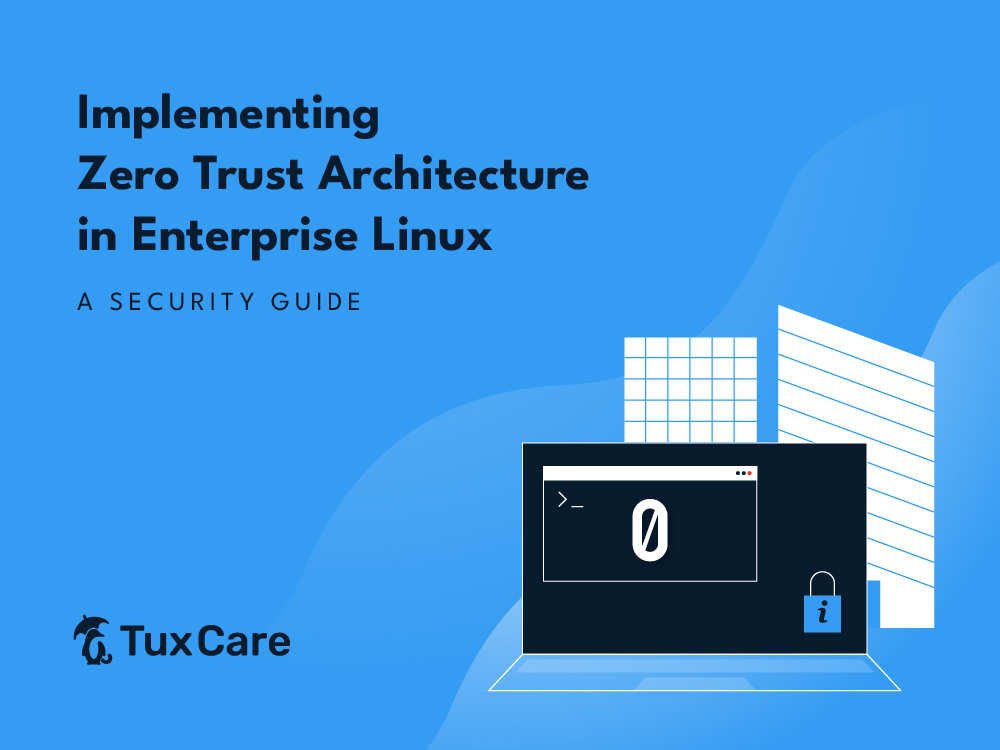Traditional security models assume that everything inside the internal network is trustworthy — but that approach no longer works. Securing modern enterprise environments demands more than traditional cybersecurity defenses. This means adapting security measures to counter threats that have evolved beyond those used for perimeter defenses.
This is why enterprises are shifting to Zero Trust Architecture (ZTA). But how do you implement Zero Trust security on Linux? This guide provides actionable steps – from enforcing multi-factor authentication and micro segmentation to continuous monitoring – so you can lock down your Linux systems effectively. Let’s get started.
What Is Zero Trust Architecture?
Zero Trust Architecture (ZTA) is a security model that is based on the principle of “never trust, always verify.” This essentially means users, devices, and applications don’t get implicit trust regardless of whether it operates inside or outside the enterprise network.
Unlike traditional security perimeters, ZTA “puts the wall” at the individual resource level instead of the whole-network level. The core principles include least privilege access, micro-segmentation, and continuous authentication. In Linux enterprise environments, this translates to locking down access, enforcing role-based controls, and segmenting networks to prevent lateral movement. By requiring continuous verification of every access request, ZTA eliminates blind trust, mitigating risks associated with misconfigurations, outdated software, and privilege escalation vulnerabilities.
Practical Steps to Implement Zero Trust in Linux Enterprises
Zero Trust is only effective if properly enforced at the system level. The following steps provide practical implementation measures and examples to help system administrators integrate zero trust architecture in their Linux infrastructures.
1. Strengthen Identity and Access Control
Tightening identity and access management prevents unauthorized users from gaining access to critical systems.
Enforce Multi-Factor Authentication (MFA) for SSH
MFA significantly enhances security by requiring multiple authentication factors. Here’s how to implement it using Google Authenticator:
Step 1: Install Google Authenticator
On Debian/Ubuntu:
sudo apt install libpam-google-authenticator
On RHEL/AlmaLinux/Rocky Linux:
sudo dnf install google-authenticatorNext, run this command to configure the Google Authenticator.
sudo google-authenticator
You should see the following prompt. Type y and Press Enter.
Do you want authentication tokens to be time-based (y/n) y
It generates a QR code and a secret key. Scan the QR code with your app authenticator like Google Authenticator and enter the code from the app in the terminal. Then answer the rest of the questions to complete the process.

Step 2: Enables MFA in SSH
Edit /etc/pam.d/sshd and add the following line before other such lines:
auth required pam_google_authenticator.so nullok
Edit the file using your favorite text editor.
sudo nano /etc/pam.d/sshd
Step 3: Configure SSH to Require MFA
Edit /etc/ssh/sshd_config and change to yes in this line to enable challenge-response authentication:
KbdInteractiveAuthentication yes

At last, restart SSH to apply the changes.
sudo systemctl restart sshdEnforce Least Privilege Principle
You can restrict SSH access to specific users by editing /etc/ssh/sshd_config:
sudo nano /etc/ssh/sshd_config
Add the following line in the file:
AllowUsers user1 user2
Restart SSH service:
sudo systemctl restart sshd
Implement Role-Based Access Control (RBAC) with Sudo
You can use sudo for RBAC and have granular control over administrative privileges.
For example, create an Admin Group using this command:
sudo groupadd admins
Add Users to the Admin Group:
sudo usermod -aG admins username
Edit Sudoers File (using visudo):
sudo visudo
Add Granular Sudo Rules (Examples):
- Allow users in the “admins” group to reboot
%admins ALL=(ALL:ALL) /sbin/reboot
- Allow users in the “admins” group to update packages
%admins ALL=(root:root) /usr/bin/apt update, /usr/bin/apt upgrade
- Allow a specific user to run a specific script.
username ALL=(ALL:ALL) /usr/bin/my_script.sh
Note: Avoid using %admins ALL=(ALL) ALL as it grants excessive privileges.
2. Secure Linux Workloads with Micro-Segmentation
Segmenting workloads prevents attackers from moving laterally within your network.
Configure a Firewall to Restrict Unnecessary Traffic
Block all incoming traffic except SSH and essential services:
sudo ufw default deny incoming sudo ufw allow ssh sudo ufw enable
For iptable users:
sudo iptables -P INPUT DROP
Enforce SELinux or AppArmor for Process Isolation
Enable SELinux enforcing mode (RHEL/CentOS/AlmaLinux/Rocky Linux):
sudo setenforce 1 sudo sed -i 's/SELINUX=permissive/SELINUX=enforcing/' /etc/selinux/config
Check SELinux policy violations:
sudo ausearch -m avc
For Ubuntu users, use AppArmor:
sudo apparmor_status
AppArmor is installed and enabled by default in the Ubuntu system. If it is disabled, run these commands to start and enable apparmor to start automatically at system boot.
sudo systemctl start apparmor sudo systemctl enable apparmor
3. Continuous Monitoring and Threat Detection
A zero trust architecture should include real-time monitoring to detect and respond to threats before they escalate. System administrators can configure audit logging, SIEM integrations, host based intrusion detection, and automated responses to enforce security policies effectively.
Enable Audit Logging with auditd
Install auditd on Debian/Ubuntu:
sudo apt install auditd
Install auditd on RHEL/AlmaLinux/Rocky Linux:
sudo yum install audit sudo systemctl start auditd sudo systemctl enable auditd
Configure Rules (Examples):
Monitor /etc/passwd changes:
sudo auditctl -w /etc/passwd -p wa -k passwd_changes
Monitor /etc/sudoers changes:
sudo auditctl -w /etc/sudoers -p wa -k sudoers_changes
Monitor critical directories:
sudo auditctl -w /var/log/ -p wa -k log_changes
Monitor specific system calls (e.g., execve):
sudo auditctl -a always,exit -F arch=b64 -S execve -k process_execution
View Audit Logs:
sudo ausearch -k passwd_changes
Interpret Logs: Use ausearch with various options to filter and analyze logs.
Log Rotation: Configure log rotation for /var/log/audit/audit.log using logrotate.
Enable Malware Scanning with ClamAV
Malware scanning provides an additional layer of defense against malicious software.
Install ClamAV on Ubuntu/Debian:
sudo apt install clamav clamav-daemon
Install ClamAV on RHEL/AlmaLinux/Rocky Linux:
sudo dnf install clamav
Start and enable clamav-freshclam service:
After the installation completes, run this command to update virus databases.
sudo freshclam
The clamscan command is used to scan the files in the specified directories. For example, this command checks the /home/tuxcare directory and displays the scan summary.
sudo clamscan --infected --remove -r /home/tuxcare
Scheduled Scans:
Create a cron job to run clamscan regularly.
sudo crontab -e
Example: 0 0 * * * sudo clamscan -r / –exclude-dir=”^/sys|^/proc|^/dev”
Here,
0 0 * * *: This schedules the job to run at midnight every day.
sudo clamscan -r /: This runs clamscan to recursively scan the entire system for malware or viruses.–exclude-dir=”^/sys|^/proc|^/dev”: This option tells ClamAV to exclude certain directories (/sys, /proc, /dev) from the scan. These directories contain system files, virtual filesystems, or devices that are not typically useful to scan for viruses.
4. Patch Management with Zero Downtime
Vulnerabilities in unpatched Linux systems are a primary attack vector. To minimize risk, zero trust architecture requires continuous patching without downtime — something traditional patching methods struggle with in enterprise environments.
TuxCare’s KernelCare Enterprise eliminates this issue with rebootless patching, allowing you to apply security patches to a running kernel without having to reboot the system or schedule maintenance windows. It automates the patching process, ensuring security updates are deployed immediately when they are available.
With KernelCare installed, teams can eliminate the vulnerability window caused by waiting for a reboot and easier maintain compliance in their enterprise systems. KernelCare offers rebootless patching for all popular enterprise Linux distributions, including RHEL, CentOS, AlmaLinux, CloudLinux, Rocky Linux, Ubuntu, Oracle Linux, and Amazon Linux.
Final Thoughts
Implementing Zero Trust Architecture in enterprise environments requires a shift from traditional perimeter-based security to a dynamic, identity-driven approach. By enforcing strong authentication, micro-segmentation, continuous monitoring, and strict access controls, organizations can significantly reduce attack surfaces and prevent lateral movement.
However, Zero Trust is not a one-time deployment — it’s an ongoing strategy that must adapt to evolving threats. Regular audits, automated security updates, and strict policy enforcement are essential for maintaining a strong security posture. By following these best practices, Linux administrators can better protect critical assets from modern cyber threats.
Summary

Implementing Zero Trust Architecture in Linux: A Security Guide
Description
Enhance Linux security with Zero Trust Architecture (ZTA). Learn practical steps to implement ZTA on Linux for enterprise environments.
Author
Rohan Timalsina
TuxCare
Publisher Logo

💸 Affordable Cloud Servers in Argentina! 🚀
At Full Tech Solutions, we offer Affordable Cloud Servers with high performance and advanced security, perfect for entrepreneurs, businesses, and developers looking for power at a budget-friendly price.
💰 Competitive Pricing: Power and flexibility without breaking the bank.
⚡ High Performance: Speed and stability for your applications.
🔒 Advanced Security: Protect your data with cutting-edge technology.
📞 24/7 Support: Our experts are ready to assist you anytime.
Don’t compromise quality for cost. Choose Full Tech Solutions and get the best affordable cloud servers in Argentina.
🌐 Scale your project with performance and savings!




